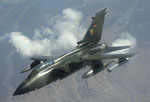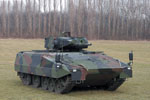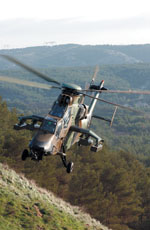Electronics Firms Adapt to New Business Environment
 |
 |
 |
| Germany’s defense electronic sector supports a number of domestic and international programs. Firms are involved in systems upgrades for the nation’s fleet of Tornado attack jets, developing the avionics for the Tiger attack helicopter and network-centric systems for the Puma infantry fighting vehicle. |
With a long and distinguished history of developing pioneering electronic systems,
The Bundeswehr has shifted its focus from Cold War-era national defense to deployed coalition operations. Schempp says that the military’s overriding goal is to improve and sustain its operational capability. Some of the needs driving these changes include continuing multinational missions with a heavy emphasis on interoperable communications systems, ensuring extensive logistical support for overseas operations, and implementing new acquisition processes for defense systems and equipment.
Another factor affecting the defense electronics industry is the Bundeswehr’s transformation into a network-centric force. During the past decade, this change has driven the development of interfaces to connect existing systems and to enhance communications. This period has been profitable for German defense electronics firms. Schempp notes that the industry enjoyed a 7 percent annual growth rate over the last five years because of the military’s transformation. He cautions, however, that shrinking defense budgets and the effects of the global financial crisis and economic slowdown will impact the industry.
Operational pressure also has caused the German Ministry of Defense to accelerate its acquisition and development process to rush new technologies to its forces. Schempp shares that the Bundeswehr is now deployed to 11 locations around the world to support multinational missions. For the last three years, the German military has had an accelerated program that bypasses the existing acquisition process to provide troops with equipment and systems. He explains that this rapid acquisition program has an annual outlay of €1 billion with the majority of the funds going to German electronics firms.
Electronics and information technology companies are in a good position to leverage these urgent operational needs because equipment such as software-defined radios can be modified rapidly for new missions, Schempp says. One example is the need to provide transport helicopters operating in
Besides supporting urgent operational needs, German electronics and information technology firms are heavily committed to a range of defense programs. Two major military modernization efforts are HERKULES and SASPF. HERKULES is a complete restructuring of the nation’s military information technology infrastructure, while SASPF will implement SAP standard software and replace more than 200 customer-specific information technology solutions. SASPF is intended to optimize all aspects of information and document management across all echelons of the German military.
Companies also are involved in supporting a number of C4ISR programs such as upgrades to
Another research and development area heavily supported by electronics and information technology firms is command, control, communications and intelligence (C3I). Major programs include a satellite communications system; FüInfosys-H, a command and control system for the German Army; FülnfoSysSK, a mission command and control system for joint and combined operations; and a nationwide network of simulators to test advanced technologies, processes and training.
German firms are heavily involved in multinational programs such as the Eurofighter Typhoon, the A-400M transport aircraft, the NH-90 and Tiger helicopters, the Medium Extended Air Defense System (MEADS) and the Artillery Systems Cooperation Activities multinational fire support operations.
But while there is domestic and international work available for German firms, a number of challenges remain. A key issue is the relationship of defense electronics and information technology firms, which are primarily small and medium-size businesses and large multinational European consortia such as EADS. Schempp notes that smaller firms primarily work as suppliers to the systems integrators. He adds that EADS subcontracts more than 40 percent of its weapons systems work to its suppliers. But smaller firms must be competitive to participate in defense programs, he says.
One way to maintain competitiveness is for small and medium-size German firms to form alliances. In some cases, these alliances can compete against the large systems firms. Schempp explains that the Ministry of Defense encourages this competition within the industry. But the disadvantage is that alliances only have an advantage in niche areas because of financial limitations. Although the government wants competition, for developmental reasons it often awards the contracts to systems companies. “These alliances could never develop a new unmanned aerial vehicle or airplane,” Schempp observes.
The German government has revised its acquisition process as well. Schempp explains that because of smaller budgets, the Ministry of Defense now expects up-front investments from the primary suppliers of weapons system programs. Contracting firms must invest in developing prototypes to compete for programs. The result of this policy, he notes, is that only large firms can afford to develop new systems. Large firms also attempt to share the risk with their suppliers. “That quickly brings small and medium enterprises to their financial limits,” Schempp explains.
While alliances usually do not have the resources to develop a platform, Schempp admits that under some circumstances, it is possible for a business alliance to compete with larger system houses successfully. He observes that very little ongoing development of new weapons systems is occurring in
The Ministry of Defense also is creating larger programs that exceed the financial ability of all but the largest alliances. Schempp says the potential price of these developments is dependence on a few systems companies, which affects competitiveness and impacts project costs. In some program areas, system-level competitions have been eliminated, which serves to intensify competition at the subsystem and component levels.
Although domestic opportunities exist for homeland security applications, the opportunities remain limited because government organizations such as
Exports are another key market for German firms. Schempp notes that large systems companies such as EADS drive much of this overseas business. Individual electronics companies are having difficulty keeping up. He adds that German electronics firms have begun to establish offices around the world, but they are following the systems firms. This is primarily because the large integrators are the only firms capable of winning contracts outside of
International pressures also affect the nation’s defense electronics firms. One of the challenges facing local businesses is that the German market is completely open, which allows foreign firms to compete with German companies for military and homeland security programs. But the European market is not an even playing field. Schempp explains that paragraph 296 of the European Union treaty is designed to protect a country’s defense market and industry by restricting requests for proposal to national companies. “
Schempp adds that 40 percent of
Despite these issues, Schempp contends that the German electronics industry is well-positioned and prepared to weather these changes. He adds that the success of the industry will be determined by its ability to implement new and proven technologies in military systems and process-support solutions. Additional market opportunities exist in the area of technology transfer between the military and other state security forces for use in homeland security, border control and protecting critical infrastructures. The Bundeswehr fiscal plan for 2009 and German government research initiatives offer additional possibilities for dual-use technologies. He predicts that this favorable environment, combined with expected innovations in electronics and information technologies, could provide the industry with a compounded growth rate of approximately 5 percent in coming years.
Web Resource
German Electrical and Electronic Manufacturer’s Association (German language): www.zvei.org




Comments